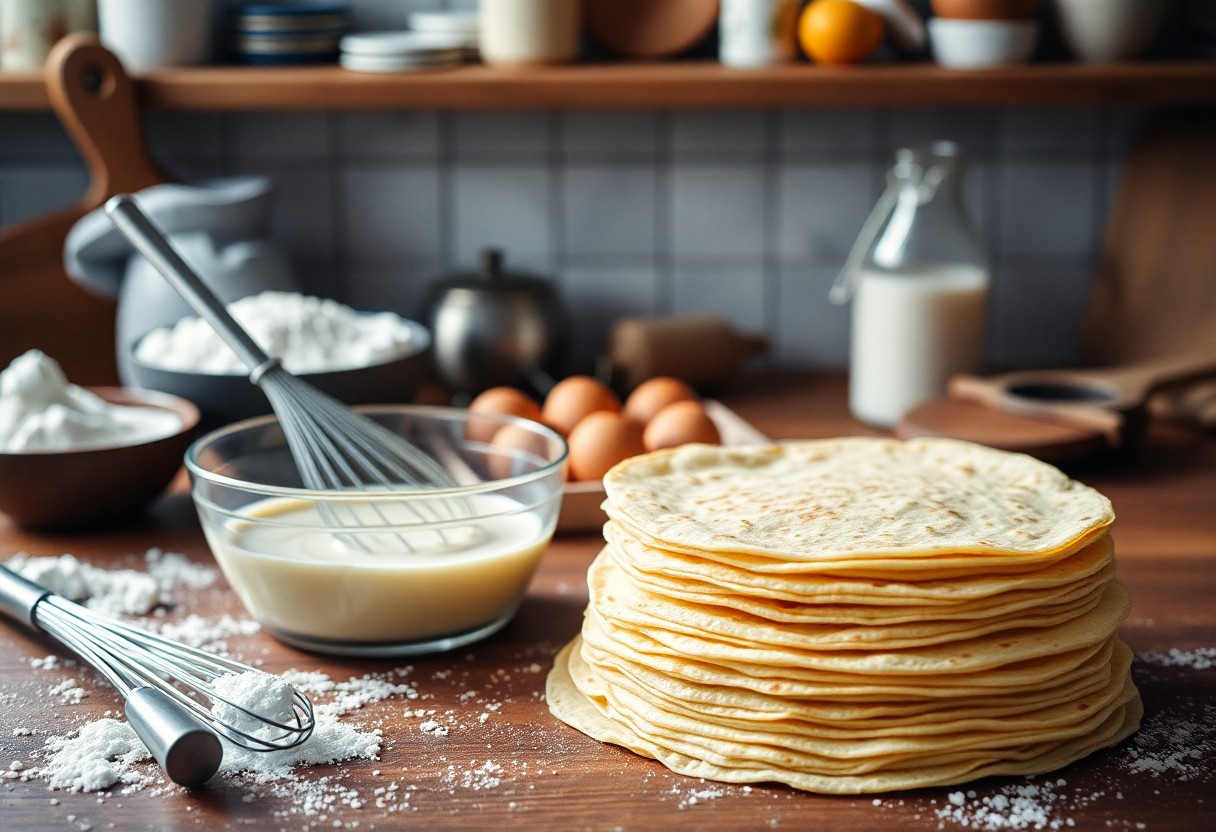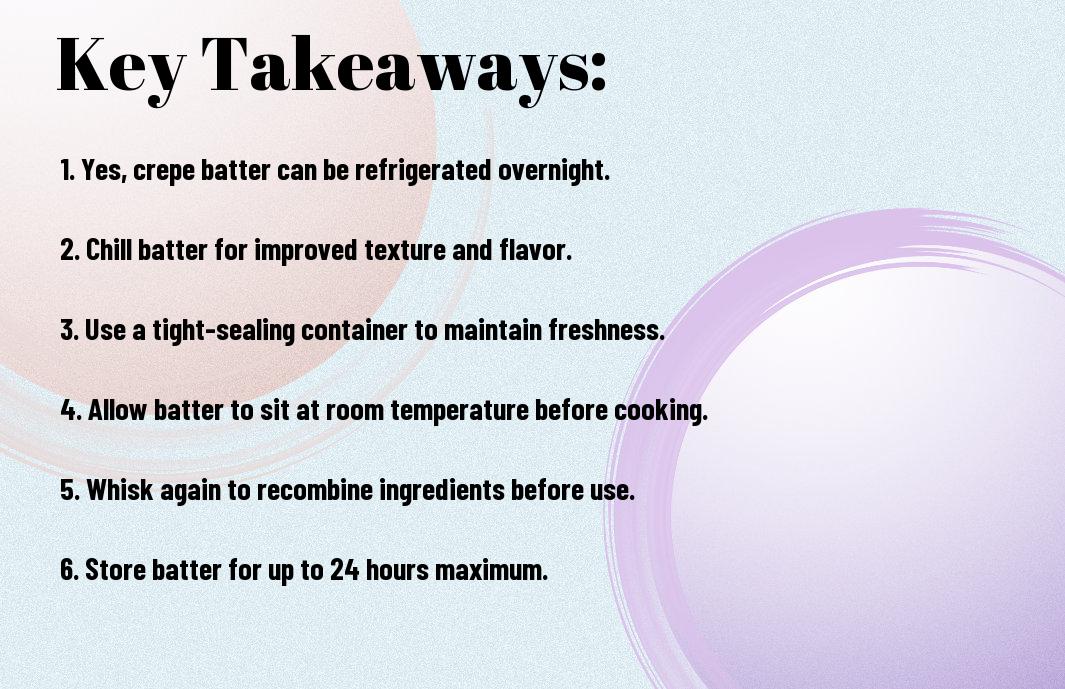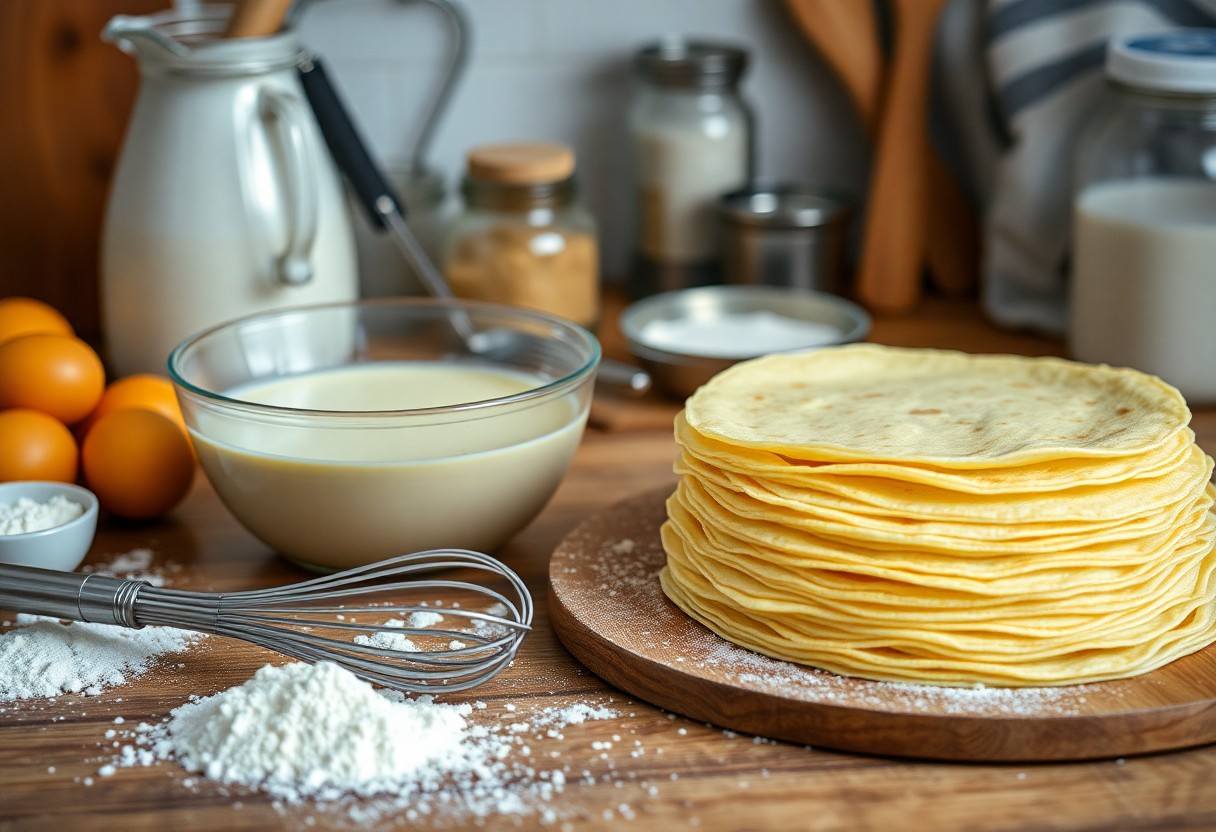You may be wondering if crepe batter can be made the night before to save time for your breakfast or brunch plans. The answer is yes! Creating your batter ahead of time can enhance the flavors, allowing the ingredients to fully combine and improve the overall texture of your crepes. However, it’s imperative to store your batter properly in the refrigerator and allow it to rest before cooking. In this guide, you’ll discover expert tips to ensure your crepes turn out perfectly delicious every time.
Key Takeaways:
- Crepe batter can be prepared the night before and refrigerated to enhance the flavors and improve the texture.
- Allow the batter to rest in the fridge for at least a few hours, ideally overnight, for the best results when cooking crepes.
- Before using the batter, give it a good stir to recombine any ingredients that may have settled or separated during storage.

Understanding Crepe Batter
Before submerging into the details, it’s crucial to grasp the fundamentals of crepe batter. This simple yet versatile mixture forms the base of your delicious crepes. The ingredients blend together to create a smooth, pourable consistency that allows for even cooking and delightful texture. Understanding the components will help you achieve the perfect crepe every time.
Ingredients Used
Before you start making your crepes, familiarize yourself with the key ingredients. Typically, you’ll need flour, eggs, milk, and a pinch of salt. Some recipes call for additional elements like sugar or vanilla for sweetness, or melted butter for richness. Choosing high-quality ingredients can elevate your crepes to the next level.
The Importance of Resting
The resting period for your batter is crucial for achieving the best crepes. Allowing your batter to sit for at least 30 minutes helps the gluten in the flour relax, leading to a tender texture. This process also allows the flour to fully hydrate, resulting in a smoother consistency.
And when you let your batter rest, you avoid tough crepes that may not fold or roll as gracefully. This time allows for a better blend of flavors and can lead to a more even cooking experience. If you prepare your batter the night before, keep it covered in the refrigerator to maintain its freshness. Just be sure to give it a quick stir before using, as it may separate slightly while resting. Trust this simple step to make your crepes consistently delightful!

Making Crepe Batter in Advance
Any home cook can benefit from making their crepe batter the night before. Preparing your batter in advance not only saves time on the day you plan to serve the crepes, but it also allows the flavors to meld beautifully, resulting in a more enjoyable dish. Ensure you whisk the ingredients well and store the batter in the refrigerator, so it’s ready to be cooked when you are.
Storage Tips
Among the best practices for storing your crepe batter are:
- Use an airtight container to prevent any absorption of odors.
- Cover the surface of the batter with plastic wrap to avoid a skin forming.
- Label the container with the date to track freshness.
The key is to keep your batter cool and well-covered for optimal results.
How Long Can You Store Crepe Batter?
Before using your crepe batter, it’s important to know how long you can keep it stored. Typically, you can refrigerate it for up to 24 hours without any issues. After that, the batter may lose its quality and texture, affecting the cooking process. If you’re thinking of keeping it longer, consider freezing it, but do so in a well-labeled, airtight container.
Indeed, while fresh crepe batter yields the best results, you have the flexibility to store it safely for a short period. Quality diminishes after 24 hours in the refrigerator due to potential bacterial growth and changes in texture. If you opt for freezing, use within 1-2 months for optimal flavor and consistency. Always give the batter a gentle stir after storage, and check for any off odors before cooking. Your delicious crepes await!
Reheating and Adjustments
To achieve the best results with your crepes, proper reheating and adjustments to the batter may be necessary. When you’re ready to cook your crepes, ensure the batter has the proper texture by following these tips.
Tips for Reheating Batter
Reheating your batter correctly can maintain its consistency and prevent clumping. Here are some helpful tips:
- Gently warm the batter in the microwave for short intervals.
- Stir thoroughly to mix any settled ingredients.
- Add a small amount of milk or water if the batter appears too thick.
The key is to ensure a smooth and pourable batter before cooking your crepes.
Adjustments for Consistency
After reheating, you may find the batter is not quite right for optimal crepe making. It might need a few adjustments to achieve the perfect consistency.
Adjustments are simple: if your batter feels overly thick after sitting overnight, add a little milk or water, stirring well to blend. Conversely, if it’s too thin, a small amount of flour can help thicken it. This ensures a smooth pour, allowing for even cooking and beautifully delicate crepes. Make adjustments gradually for the best outcome!
Tips for the Best Crepes
All crepe enthusiasts know that a few simple tips can elevate your crepe-making experience. To ensure success, consider the following:
- Keep your batter chilled overnight for enhanced flavor.
- Use a fine strainer to eliminate lumps in your batter.
- Don’t rush the cooking process; give your crepes enough time to set.
- Experiment with various fillings to discover your favorite combinations.
Recognizing attention to these details will undoubtedly lead to the best crepes.
Cooking Techniques
On your journey to perfect crepes, mastering cooking techniques is imperative. Start by preheating your pan on medium heat, ensuring it’s adequately hot before adding any batter. Use a ladle to pour just the right amount of batter, swirling it evenly to form a thin layer. When edges lift easily with a spatula, it’s time to flip. Cook until both sides are golden brown for a delightful texture.
Choosing the Right Pan
Techniques for selecting the right pan can significantly impact your crepe-making results. You should opt for a flat non-stick skillet or a dedicated crepe pan, which allows for even heat distribution and easy flipping. Ensure your pan has low sides for effortless access to slide the crepe out. For even better results, look for pans made from materials like cast iron or non-stick surfaces, providing a perfect cooking environment. Maintaining a stable temperature is also important, as a hot pan will create a delightful golden finish, while a low temperature may lead to uneven cooking. This knowledge will help you achieve perfectly cooked crepes with ease!

Common Mistakes to Avoid
Now that you’re ready to make delicious crepes, it’s important to steer clear of common pitfalls that can ruin your batter. Be vigilant about the consistency, resting time, and cooking method to achieve the perfect crepe. Avoiding these mistakes will help you create a beautifully thin and flavorful treat that you can enjoy any time.
Overmixing the Batter
About mixing, it’s tempting to overwork your crepe batter to achieve a smooth texture. However, doing so can lead to a tough final product. The key is to mix just until the ingredients are incorporated which allows gluten to remain relaxed, ensuring your crepes are tender and easy to fold.
Skipping the Rest Period
Before you start cooking, take a moment to let your batter rest. Skipping this important step can affect the texture and flavor of your crepes. Allowing the batter to sit for at least 30 minutes before cooking gives the flour time to hydrate and relax, resulting in more uniform and tender crepes. This simple process also helps to eliminate air bubbles, which can impact the crepe’s structure and make cooking uneven.
A well-rested batter is important for achieving thin, delicate crepes. The resting period allows the starches to absorb the liquid, which contributes to a smoother batter. Additionally, the gluten relaxes, preventing your crepes from becoming chewy. Remember that you can maximize flavor and texture with this waiting time, so aim for at least 30 minutes of downtime in the fridge before hitting the stove!
Creative Crepe Fillings
Many people overlook the versatility of crepes when it comes to stuffing them with delicious fillings. Whether you’re in the mood for something sweet or savory, your crepes can be transformed into a delightful meal or dessert. With just a few creative ideas, you can elevate your crepe experience and impress your family and friends.
Sweet Fillings
After a delightful meal, sweet crepes can be a perfect way to satisfy your cravings. Popular options include classic fillings like nutella and banana or fresh berries with whipped cream. You might also consider chocolate sauce drizzled over cream cheese or a delightful combination of strawberries and mascarpone. The sweet possibilities are endless!
Savory Fillings
Among the many delicious options for crepe fillings, savory ingredients can offer a satisfying meal experience. You can stuff your crepes with ingredients like cheese, ham, sautéed vegetables, or even a rich mushroom sauce.
In fact, with savory fillings, you can get really creative! You might try a classic combination like spinach and feta for a Mediterranean twist, or build a tasty filling with smoked salmon, cream cheese, and capers. For a heartier option, consider incorporating chicken, pesto, and mozzarella, which creates a wonderful flavor balance. The savory fillings not only ensure you enjoy hearty meals, but they also leave your taste buds dancing with every bite.
To wrap up
Hence, preparing your crepe batter the night before can save you time and lead to delicious results. By allowing the batter to rest in the refrigerator, you create a smoother texture and enhance the flavors. Just make sure to give it a good whisk before use to reintroduce any separated ingredients. With these tips, you’ll ensure your crepes are light, thin, and perfect for any filling you desire. Enjoy your crepe-making adventure and impress your guests with effortlessly delightful creations.
FAQ
Q: Can crepe batter be made the night before?
A: Yes, crepe batter can be made the night before. After preparing the batter, store it in an airtight container in the refrigerator. Allowing it to rest overnight can improve the texture of the crepes, making them lighter and more tender when cooked.
Q: How long can I store crepe batter in the refrigerator?
A: Crepe batter can be stored in the refrigerator for up to 24 hours. If you need to keep it longer, consider freezing it. When freezing, make sure to use an airtight container or a freezer bag. When ready to use, thaw it in the refrigerator and give it a good stir before cooking.
Q: Do I need to adjust the ingredient proportions if making batter the night before?
A: No, you don’t need to adjust the ingredients when making the batter ahead of time. Use the same proportions as you normally would. However, which ingredients you use may affect the batter’s resting time, with recipes containing milk typically producing better results when allowed to sit.
Q: What are some tips for ensuring the best crepes when using overnight batter?
A: To ensure the best crepes, strain the batter through a fine sieve to remove any lumps after letting it rest overnight. This helps achieve a smooth consistency. Additionally, let the batter come to room temperature before cooking—this can help with even cooking and prevent the crepes from being too cold when they hit the hot pan.
Q: Can I add flavors to the crepe batter before storing it overnight?
A: Yes, you can enhance your crepe batter with flavors such as vanilla extract, citrus zest, or spices before storing it. Just be mindful of the amounts, as strong flavors can intensify during the resting period. Adding flavors creates unique delicious crepes that can pair well with both sweet and savory fillings!
